(完整版)中国故宫(紫禁城)英文版详细介绍
- 格式:ppt
- 大小:8.07 MB
- 文档页数:43
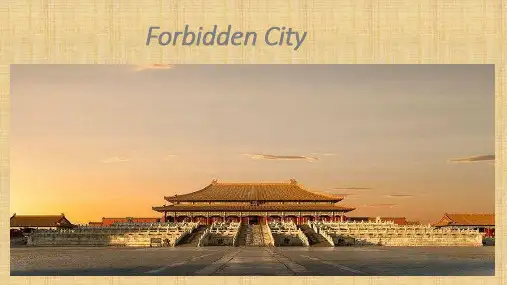

介绍紫禁城的作文英语英文:The Forbidden City, also known as the Imperial Palace, is a magnificent architectural complex located in the heart of Beijing, China. It was the Chinese imperial palace from the Ming dynasty to the end of the Qing dynasty, and it served as the political and ceremonial center of the Chinese government for almost 500 years.The Forbidden City is a symbol of ancient Chinese culture and architecture. It is a vast complex consisting of 980 surviving buildings with 8,704 rooms, and it covers an area of 180 acres. The architecture of the Forbidden City is a perfect example of traditional Chinese palatial architecture, with its grand halls, intricate courtyards, and beautiful gardens.One of the most impressive features of the Forbidden City is its magnificent gates. The Meridian Gate, the Gateof Supreme Harmony, and the Gate of Heavenly Purity arejust a few of the many stunning gates that lead visitors into the various sections of the palace. Each gate is adorned with intricate carvings and colorful paintings, showcasing the exquisite craftsmanship of the ancient Chinese artisans.Another highlight of the Forbidden City is the Hall of Supreme Harmony, which was the ceremonial center of the palace. This grand hall was where the emperor would hold important state ceremonies and receive foreign ambassadors. The hall is adorned with magnificent dragon motifs, symbolizing the emperor's power and authority.In addition to its architectural splendor, the Forbidden City also houses a vast collection of cultural and historical artifacts, including paintings, ceramics, and imperial treasures. The Palace Museum, located within the Forbidden City, is home to over 1.8 million art pieces and artifacts, making it one of the most important museums in China.Visiting the Forbidden City is like stepping back in time and immersing oneself in the rich history and cultureof ancient China. As I walked through the grand courtyards and intricate halls, I couldn't help but feel a sense of awe and wonder at the sheer magnitude and beauty of this historic site.中文:紫禁城,又称故宫,是位于中国北京市中心的一座宏伟建筑群。
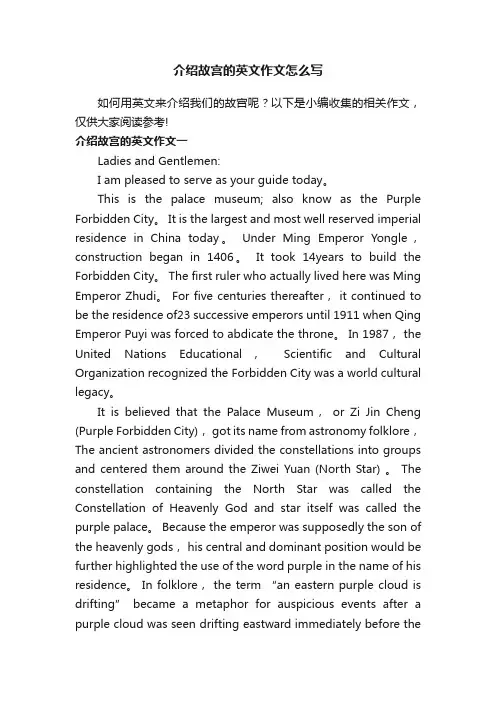
介绍故宫的英文作文怎么写如何用英文来介绍我们的故宫呢?以下是小编收集的相关作文,仅供大家阅读参考!介绍故宫的英文作文一Ladies and Gentlemen:I am pleased to serve as your guide today。
This is the palace museum; also know as the Purple Forbidden City。
It is the largest and most well reserved imperial residence in China today。
Under Ming Emperor Yongle,construction began in 1406。
It took 14years to build the Forbidden City。
The first ruler who actually lived here was Ming Emperor Zhudi。
For five centuries thereafter, it continued to be the residence of23 successive emperors until 1911 when Qing Emperor Puyi was forced to abdicate the throne。
In 1987, the United Nations Educational,Scientific and Cultural Organization recognized the Forbidden City was a world cultural legacy。
It is believed that the Palace Museum,or Zi Jin Cheng (Purple Forbidden City), got its name from astronomy folklore,The ancient astronomers divided the constellations into groups and centered them around the Ziwei Yuan (North Star) 。
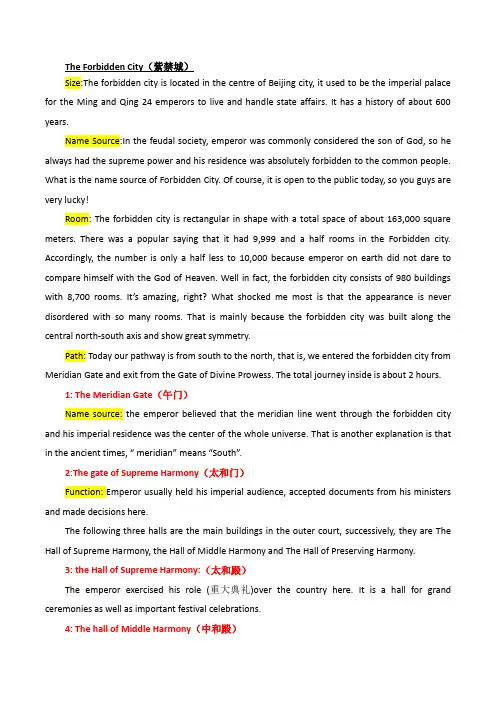
The Forbidden City(紫禁城)Size:The forbidden city is located in the centre of Beijing city, it used to be the imperial palace for the Ming and Qing 24 emperors to live and handle state affairs. It has a history of about 600 years.Name Source:In the feudal society, emperor was commonly considered the son of God, so he always had the supreme power and his residence was absolutely forbidden to the common people. What is the name source of Forbidden City. Of course, it is open to the public today, so you guys are very lucky!Room: The forbidden city is rectangular in shape with a total space of about 163,000 square meters. There was a popular saying that it had 9,999 and a half rooms in the Forbidden city. Accordingly, the number is only a half less to 10,000 because emperor on earth did not dare to compare himself with the God of Heaven. Well in fact, the forbidden city consists of 980 buildings with 8,700 rooms. It’s amazing, right? What shocked me most is that the appearance is never disordered with so many rooms. That is mainly because the forbidden city was built along the central north-south axis and show great symmetry.Path: Today our pathway is from south to the north, that is, we entered the forbidden city from Meridian Gate and exit from the Gate of Divine Prowess. The total journey inside is about 2 hours.1: The Meridian Gate(午门)Name source: the emperor believed that the meridian line went through the forbidden city and his imperial residence was the center of the whole universe. That is another explanation is that in the ancient times, “ meridian” means “South”.2:The gate of Supreme Harmony(太和门)Function: Emperor usually held his imperial audience, accepted documents from his ministers and made decisions here.The following three halls are the main buildings in the outer court, successively, they are The Hall of Supreme Harmony, the Hall of Middle Harmony and The Hall of Preserving Harmony.3: the Hall of Supreme Harmony:(太和殿)The emperor exercised his role (重大典礼)over the country here. It is a hall for grand ceremonies as well as important festival celebrations.4: The hall of Middle Harmony(中和殿)The name of Middle comes from the Confucius idea of “mean” and “impartial”. It is a place for the emperor to take a short rest. In Qing Dynasty, the emperor usually came here and examined the tools for ploughing(农耕)in spring time. Besides that, the emperor also held ceremony of presenting the genealogy revision and approval.5: the hall of Preserving Harmony(保和殿)It is a place for the emperor to have banquets to entertain the civil and military officials. Later in Qing Dynasty, emperor held the Imperial Palace examination here. Attention! There is no pillar in its front part.When you are walking through the Gate of Heavenly Purity(乾清门), you have entered the Inner Court.Resembling to the outer court, there are also three main buildings inside, the first one you are seeing is6:The palace of Heavenly Purity(乾清宫)In Ming and Early Qing Dynasty, emperors used to live here and handle the daily affairs. Later after emperor Yongzheng, it was changed to be an audience chamber for receiving foreign ambassadors and envoys form vassal states.8:the palace of Union and Peace(交泰殿)It is a place where the empress held the important ceremonies and her birthday celebration. in Qing Dynasty, the empress usually came here and examined the tools for picking mulberry in spring time.Name source: the name of this palace came from the book of Changes(ZHOU YI), which means the intercourse of heaven & earth, harmony of positive & negative, as well as the harmony between emperor & empress.7: The palace of Earthly Tranquility(坤宁宫)In Ming and Early Qing Dynasty, it was used as empress’s residence. Later ,the hall was completely reconstructed by imitating Qingning Palace(清宁宫) in Shenyang according to the Manchu’s custom.8:The Imperial Garden(御花园)it is about 12,000 square meters, containing more than 20 different types of buildings , pavilions, terraces etc. you can also see lots of pine trees, cypress trees and other botanies.Undoubtedly, the Imperial Garden is an ideal place for entertainment and relaxation.Ok, it is almost the end of our visit in the Forbidden city. You can have a 5 minutes short break here. The toilet is …….., please come back at…….The last spot is the Gate of Divine Prowess(神武门). Actually, the name of the gate was Xuanwumen at first, but when to Emperor Kangxi, as his name is Xuanye, the gate’s name had the same pronunciation with emperor’s name. You know, it was a serious taboo for mentioning the emperor’s name in ancient times. Hence the gate’s name was finally changed to “Shenwumen”.。
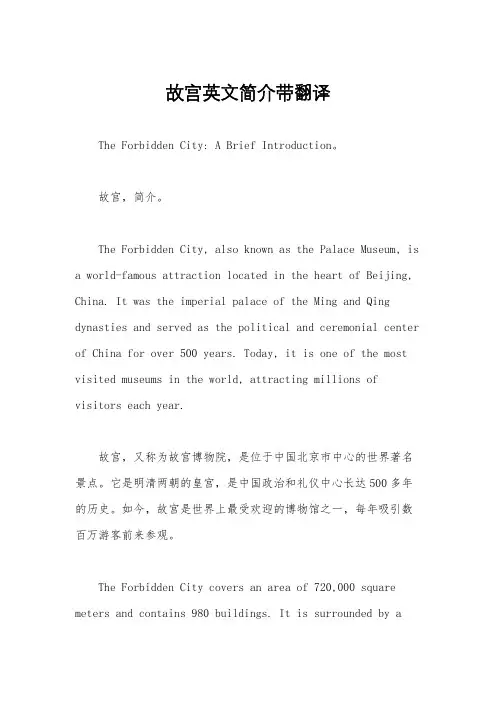
故宫英文简介带翻译The Forbidden City: A Brief Introduction。
故宫,简介。
The Forbidden City, also known as the Palace Museum, is a world-famous attraction located in the heart of Beijing, China. It was the imperial palace of the Ming and Qing dynasties and served as the political and ceremonial center of China for over 500 years. Today, it is one of the most visited museums in the world, attracting millions of visitors each year.故宫,又称为故宫博物院,是位于中国北京市中心的世界著名景点。
它是明清两朝的皇宫,是中国政治和礼仪中心长达500多年的历史。
如今,故宫是世界上最受欢迎的博物馆之一,每年吸引数百万游客前来参观。
The Forbidden City covers an area of 720,000 square meters and contains 980 buildings. It is surrounded by a52-meter-wide moat and a 10-meter-high wall. The palace complex is divided into two parts: the Outer Court, where the emperor held grand ceremonies and conducted state affairs, and the Inner Court, where the emperor and his family lived.故宫占地面积达72万平方米,包括980座建筑。

紫禁城的简单介绍英语作文The Forbidden City, also known as the Palace Museum, was the imperial palace of the Ming and Qing dynasties. Located in the center of Beijing, it was the political and cultural center of China for over 500 years.The construction of the Forbidden City started in 1406 and was completed in 1420. It covers an area of 720,000 square meters and has over 9,000 rooms. The palace is surrounded by a moat and a 10-meter-high wall, which symbolized the emperor's supreme power and authority.The Forbidden City is divided into two parts: the Outer Court and the Inner Court. The Outer Court consists of three main halls: the Hall of Supreme Harmony, the Hall of Central Harmony, and the Hall of Preserving Harmony. These halls were used for important ceremonies and imperial meetings. The Inner Court was where the emperor and his family lived. The most famous building in the Inner Courtis the Palace of Heavenly Purity, where the emperor wouldsleep and conduct his daily business.The Forbidden City is not only a symbol of China's rich history and culture but also a masterpiece of ancient architecture. The palace is decorated with intricate carvings, colorful paintings, and beautiful gardens. It is a testament to the skill and craftsmanship of the ancient Chinese people.Today, the Forbidden City is a popular tourist destination and a UNESCO World Heritage Site. Visitors can explore the palace and learn about China's imperial past.It is a must-see attraction for anyone visiting Beijing.In conclusion, the Forbidden City is a remarkable piece of Chinese history and culture. Its grandeur and beauty continue to captivate visitors from all over the world. It is a true treasure of China and a testament to thecountry's rich cultural heritage.。
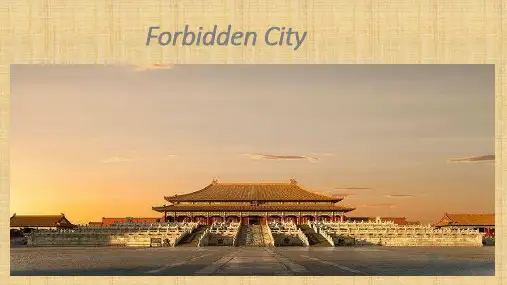
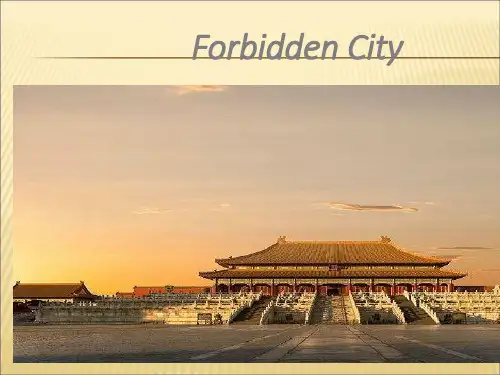

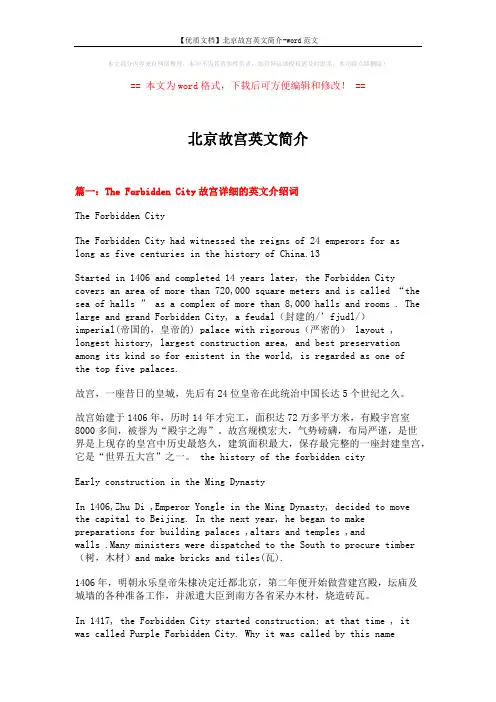
本文部分内容来自网络整理,本司不为其真实性负责,如有异议或侵权请及时联系,本司将立即删除!== 本文为word格式,下载后可方便编辑和修改! ==北京故宫英文简介篇一:The Forbidden City故宫详细的英文介绍词The Forbidden CityThe Forbidden City had witnessed the reigns of 24 emperors for aslong as five centuries in the history of China.13Started in 1406 and completed 14 years later, the Forbidden City covers an area of more than 720,000 square meters and is called “the sea of halls ” as a complex of more than 8,000 halls and rooms . The large and grand Forbidden City, a feudal(封建的/’fjudl/)imperial(帝国的,皇帝的) palace with rigorous(严密的) layout , longest history, largest construction area, and best preservation among its kind so for existent in the world, is regarded as one ofthe top five palaces.故宫,一座昔日的皇城,先后有24位皇帝在此统治中国长达5个世纪之久。
故宫始建于1406年,历时14年才完工,面积达72万多平方米,有殿宇宫室8000多间,被誉为“殿宇之海”。
故宫规模宏大,气势磅礴,布局严谨,是世界是上现存的皇宫中历史最悠久,建筑面积最大,保存最完整的一座封建皇宫,它是“世界五大宫”之一。
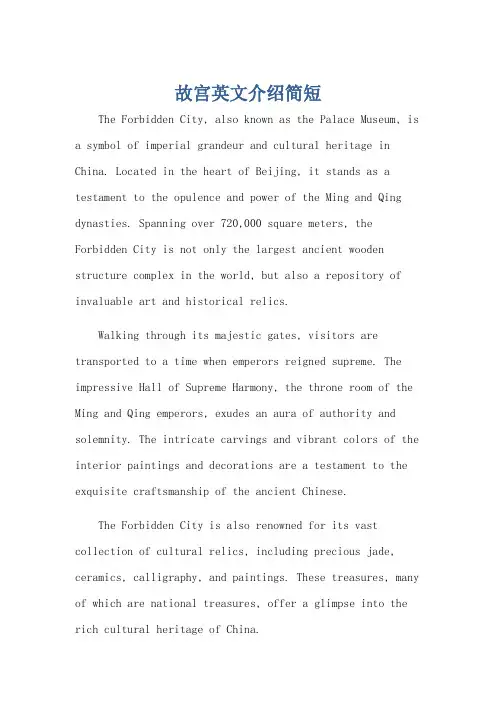
故宫英文介绍简短The Forbidden City, also known as the Palace Museum, is a symbol of imperial grandeur and cultural heritage in China. Located in the heart of Beijing, it stands as a testament to the opulence and power of the Ming and Qing dynasties. Spanning over 720,000 square meters, the Forbidden City is not only the largest ancient wooden structure complex in the world, but also a repository of invaluable art and historical relics.Walking through its majestic gates, visitors are transported to a time when emperors reigned supreme. The impressive Hall of Supreme Harmony, the throne room of the Ming and Qing emperors, exudes an aura of authority and solemnity. The intricate carvings and vibrant colors of the interior paintings and decorations are a testament to the exquisite craftsmanship of the ancient Chinese.The Forbidden City is also renowned for its vast collection of cultural relics, including precious jade, ceramics, calligraphy, and paintings. These treasures, many of which are national treasures, offer a glimpse into the rich cultural heritage of China.Moreover, the Forbidden City serves as an important educational and research center, attracting scholars and tourists alike. Its preservation and restoration efforts have been commended worldwide, ensuring that this magnificent complex remains a vibrant and living part of China's historical and cultural landscape.In conclusion, the Forbidden City is not only ahistorical monument but also a symbol of China's proud past and vibrant present. Its grandeur and beauty continue to inspire and awe visitors from all corners of the world.**故宫英文介绍简短**故宫,又称紫禁城,是中国皇权的象征与文化遗产的瑰宝。
故宫英文介绍中英对照The Forbidden City, also known as the Palace Museum, is a majestic palace complex located in the heart of Beijing, China. It served as the imperial palace for 24 emperors during the Ming and Qing dynasties, spanning over 500 years of history.Covering an area of 180 acres, the Forbidden City is the largest palace complex in the world. It is surrounded by a 26-foot high wall and a moat that symbolizes protection and security. The complex consists of 980 surviving buildings with over 8,700 rooms, showcasing traditional Chinese architecture and design.The Forbidden City is divided into two main sections: the Outer Court and the Inner Court. The Outer Court was used for ceremonial purposes, where the emperor would meet with officials and foreign dignitaries. The Hall of Supreme Harmony, the Hall of Central Harmony, and the Hall of Preserving Harmony are the main buildings in this section.The Inner Court was the living quarters for the emperor and his family. It includes the Palace of Heavenly Purity, the Hall of Union, and the Palace of Earthly Tranquility. The emperor's living quarters were located here, along with the concubines' quarters and the imperial gardens.The Forbidden City is home to a vast collection of cultural relics and artifacts, including paintings, calligraphy, ceramics, and jade. The Palace Museum houses over 1.8 million pieces of art and artifacts, making it one of the most comprehensive collections of Chinese art in the world.One of the most famous attractions in the Forbidden City is the Hall of Supreme Harmony. This grand hall was used for important ceremonies and events, such as the emperor's enthronement and birthday celebrations. It is the largest building in the complex and is adorned with intricate carvings and decorations.Visitors to the Forbidden City can explore the various halls, pavilions, and courtyards that make up this historic site. The architecture, artwork, and culturalsignificance of the Forbidden City make it a must-see destination for tourists from around the world.In 1987, the Forbidden City was designated a UNESCO World Heritage Site, recognizing its outstanding universal value and historical significance. It continues to be a symbol of China's rich cultural heritage and a testament to the country's imperial past.Overall, the Forbidden City is a remarkable architectural masterpiece that offers a glimpse into China's imperial history and traditions. Its grandeur, beauty, and historical significance make it a must-visit destination for anyone interested in Chinese culture and history.。
故宫中英文对照介绍The Palace Museum, also known as the Forbidden City, is a world-renowned cultural heritage site located in the heart of Beijing, China. It served as the imperial palace for 24 emperors during the Ming and Qing dynasties, spanning over 500 years from 1420 to 1912. Now, let's explore the magnificent Forbidden City and its fascinating history.The Forbidden City is a vast complex covering an area of 720,000 square meters, making it the largest palace complex in the world. It is surrounded by a 10-meter high wall and a moat, symbolizing the exclusivity and secrecy of the imperial palace during ancient times.The main entrance to the Forbidden City is through the Meridian Gate, which leads to the outer court. This area consists of three main halls: the Hall of Supreme Harmony, the Hall of Central Harmony, and the Hall of Preserving Harmony. These halls were used for important ceremonial occasions such as the emperor's enthronement and birthday celebrations.Moving further into the inner court, you will find the Hall of Heavenly Purity, which served as the emperor'sliving quarters. Adjacent to it is the Hall of Union, where the emperor would handle daily affairs and meet with officials. The most iconic building in the Forbidden Cityis the Palace of Heavenly Purity, which was the residenceof the emperor and his empress.Another significant area in the Forbidden City is the Imperial Garden, located at the northern end of the complex. This garden was designed as a private retreat for the imperial family, with beautiful pavilions, rockeries, and ancient trees. It offers a tranquil oasis amidst the grandeur of the palace.The Forbidden City is not only famous for itsarchitectural splendor but also for its vast collection of cultural artifacts. The Palace Museum houses over 1.8million pieces of art and historical relics, including paintings, calligraphy, ceramics, and jade carvings. These treasures provide valuable insights into Chinese history, art, and culture.Now, let's switch to Chinese to provide a brief introduction to the Forbidden City.故宫,又称为紫禁城,是位于中国北京市中心的世界知名文化遗产。
关于故宫的介绍英语作文(精选7篇)关于故宫的介绍英语作文(精选7篇)在日常生活或是工作学习中,大家对作文都再熟悉不过了吧,通过作文可以把我们那些零零散散的思想,聚集在一块。
那么,怎么去写作文呢?下面是小编为大家整理的关于故宫的介绍英语作文,欢迎大家分享。
故宫的介绍英语作文篇1This is the palace museum; also know as the Purple Forbidden City. It is the largest and most well reserved imperial residence in China today. Beijing Forbidden City is the head of the world's top five palace. The Forbidden City was built begin in 1406 and it took 14 years to built it. The first ruler who actually lived here was Ming Emperor Zhudi. North to south is 961 meters, and 753 meters from east to west. And the area of about 725,000 square meters. The Imperial Palace has 8704 rooms. In 1987 the Forbidden City was recognized a world cultural legacy.这是故宫博物院,也被称为紫禁城。
它是北京现在最大、保存最完好的宫殿。
北京故宫是世界五大宫殿之首。
紫禁城建于1906年,历时14年建造完成。
第一个明朝统治者朱棣便住在这里。
故宫南北长961米,东西宽753米,建地面积725,000平方米。
故宫英文介绍The Forbidden City, located in the heart of Beijing, China, is one of the most significant cultural and historical sites in the country. It served as the imperial palace for 24 emperors during the Ming and Qing dynasties, spanning nearly 500 years from the early 15th century to the early 20th century.Covering approximately 180 acres, the Forbidden City is the largest and best-preserved ancient wooden architecture complex in the world. It is surrounded by a large defensive wall and a moat, symbolizing the emperor's authority and power. The complex consists of around 980 buildings, including halls, gardens, and living quarters, all built according to traditional Chinese architectural principles.The Forbidden City is also a UNESCO World Heritage site, recognized for its historical significance and architectural grandeur. Today, it serves as the Palace Museum, housing a vast collection of ancient Chinese artifacts, artworks, and historical records, attracting millions of visitors each year.Visitors to the Forbidden City can explore iconic sites such as the Hall of Supreme Harmony, the Imperial Garden, and the Palace of Heavenly Purity. The intricate designs, vibrant colors, and rich history make it a must-visit destination for anyone interested in Chinese culture and history.中文翻译:故宫位于中国北京的中心,是国家最重要的文化和历史遗址之一。
小学作文故宫英文简介英文:The Forbidden City, also known as the Palace Museum, is located in the heart of Beijing, China. It was the imperial palace of the Ming and Qing dynasties, and now serves as a museum of Chinese history and culture.The Forbidden City is a massive complex, covering over 720,000 square meters and containing more than 9,000 rooms. The buildings are decorated with intricate carvings and colorful paintings, showcasing the finest examples of traditional Chinese architecture.One of the most impressive features of the Forbidden City is the Imperial Garden, which is located in the northern section of the complex. The garden is a peaceful oasis in the midst of the bustling city, and is filled with beautiful trees, flowers, and ponds.The Forbidden City is not only a symbol of China's rich history and culture, but also a testament to the incredible skill and craftsmanship of the artisans who built it. It is a must-see destination for anyone interested in Chinese history and architecture.中文:故宫,又称为紫禁城,位于中国北京市中心。
介绍故宫英语作文导语:北京故宫,古人称为紫荆城。
位于北京中轴线的中心,是世界上现存规模最大、保存最为完整的木质结构的宫殿型建筑。
以下是小编为大家整理的介绍故宫英语作文,欢迎大家阅读与借鉴!介绍故宫英语作文(1)The the Imperial Palace in Beijing is a beautiful The Grand Palace. The the Imperial Palace is also called the Forbidden City. There are 24 emperors who have lived in the two dynasties of Ming and Qing Dynasties. The the Imperial Palace of the entire building beautiful decoration, magnificent, known as one of the world's five palace.When I entered, the first show in front of me is the lamps. The lamps are "living place, beautiful scenery here, green grass, flowers blooming like a piece of brocade. The Imperial Palace is the palace of ancient buildings China's largest and most complete, a total area of more than 720 thousand square meters, the temple palace has more than 90 million rooms, very spectacular.Through the study to the palace, this is where the emperor on the morning, in front of the palace stood a gilded throne. The dragon carved on many dragons, some Shuanglongxizhu, some around each other is really vivid. I looked up and looked up, there is a large plaque on the wall, the plaque reads "open and aboveboard" four characters, four characters as if it is told ministers: "all things are open and aboveboard to do." I stand in the middle, also saw the emperor and ministers to negotiate the momentum of state.Out of the Front Gate, I once again looking at the ancient palace, the grand vision is greatly! What a beautiful the ImperialPalace!北京的故宫是个美丽的大皇宫。